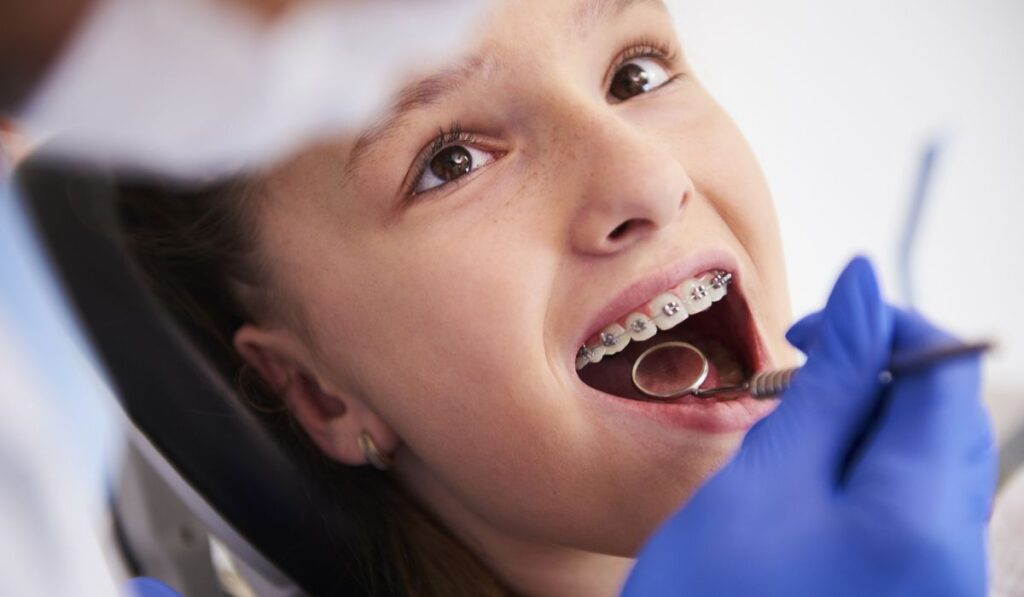Braces can accomplish remarkable results for patients who would otherwise have to suffer a lifetime of dental problems. No wonder everyone wants to know what wizardry braces can do to the mouth. So, can braces pull your teeth down?
Braces can pull down impacted teeth. An orthodontist has to fasten a small bracket to the tooth and attach it to the wire on the braces using a tiny chain. The persistent force of the chain slowly moves the tooth down and out of its impacted position, back in line with the other teeth.
Braces are an effective orthodontic solution for several dental problems. Let’s get into the details and find out how they work and how long it takes them to move your teeth.
How do Braces Work?

Before breaking down how braces work, we first need to get acquainted with its various parts. Braces require a few moving components to achieve successful teeth movement. Here are some of the most crucial ones:
- Brackets: They are the most visible part of the braces and are usually made of metal or ceramic materials. They get affixed to the surface of each tooth to keep them in position throughout the treatment.
- Archwires: These thin, rod-like metal wires are placed over individual brackets. They are significant for creating the pressure that slowly moves teeth to the desired position.
- O-Rings: They are tiny elastic bands also known as ligature elastics or ligatures. They hold the bracket on the archwire. O-rings are typically changed during each adjustment appointment and come in various colors, meaning you can make your smile more dashing.
These main components of the braces collaborate to exert constant pressure on jaws and teeth to alter their position and change your smile. The brackets affixed to the teeth keep the archwire steady, which applies pressure on the teeth. The teeth then gradually move into the desired position.
What do Braces Correct?
Soft tissues surround the teeth and bone called the periodontal ligaments, which keep teeth in place and can constrict or stretch as teeth move. For example, suppose the braces move a tooth to the right, the ligament on the right gets compressed, and a new bone forms on the left to fill up the opening.
Braces can help correct an overbite, overcrowding, and move teeth forward or down. Here’s an overview of how they achieve these remarkable feats.
Correcting Overcrowding
Overcrowding occurs when there’s discord in the tooth-to-jaw size relationship or when the teeth are larger than the available gap. Braces move teeth individually back, forward, and across to create adequate room for teeth to settle side by side.
Younger patients with overcrowding might benefit from an expander to expand their jaw size. However, the expander alone isn’t a viable option for a patient whose palate has already fused. Instead, they might have to get some tiny pins placed from the expander onto the roof of their mouth to help with expansion.
Alternatively, visiting an oral and maxillofacial surgeon could do the trick. The surgeon makes a few incisions on each side of the upper jaw, which allows the expander to enlarge the jaw structure.
Tooth extraction may also be considered as a way to make room. Naturally, your orthodontist will take you through all the workable options after carefully examining your issue.
Correcting an Overbite
An overbite occurs when your top front teeth overlap your lower teeth. Some people find it difficult to differentiate an overbite from an overjet. While in both conditions, your upper teeth overlap the bottom ones, for the overjet, the upper teeth protrude past the bottom teeth at an angle.
When treating the overbite, braces are attached to the top and lower arches of the teeth. The archwire initially straightens and aligns the teeth.
During the second stage of braces, elastics may be used to steadily move the jawline into the correct position. The elastics are fixed on the brackets from front to back or top to bottom to help move the teeth and jaw.
When managing the overjet, the braces constantly apply pressure to slowly move the upper or lower into their correct position. Sometimes the braces even move a combination of both the upper and lower teeth depending on the patient’s condition. As the teeth move, the bone around them modifies its shape to accommodate their new position.
Moving Teeth Forward
Apart from being able to push teeth towards the palate, braces can also pull teeth out towards the lips using the nickel-titanium archwire. The wire is bent to meet the bracket on the teeth, but after a while, it returns to its initial U-shape, moving the teeth forward.
Moving Teeth Down with Braces?
An experienced orthodontist can use metal or ceramic braces to move down an impacted tooth, which involves an easy surgery to open the gum and expose a small surface of the impacted tooth. The orthodontist then fastens a small bracket to the tooth, which attaches to the wire on the braces using a small chain.
The constant tension of the chain slowly moves the tooth out of its impacted position and into a place with the rest of the teeth. Once the tooth has come down, the orthodontist can apply the regular braces to adjust it into a proper position.
How Long Does it Take for a Tooth to Move Down with Braces?
Several factors affect the rate at which your teeth start to shift. Orthodontists give a range because they set a treatment schedule according to your individual needs.
As a rule of thumb, your aggregate time in braces will be between 18 and 24 months. In that period, you should start noticing slight shifts in your teeth approximately four weeks after bonding. Greater shifts that are more noticeable require more time as they become visible after around 2-3 months.
Braces need to move teeth slowly for maximum effectiveness and comfort. If an orthodontist tries to move your teeth too quickly, it will be painful and damage the teeth’s roots and the bone around them.
Your teeth need enough time to shift into the desired position and for the bone to either reabsorb or form a new bone, depending on the direction the teeth are moving.
If you get frustrated or disheartened during the braces treatment period, remember your objective of acquiring a pretty smile. In addition, exercising extensive dental hygiene habits and regularly visiting the orthodontist is vital in safeguarding the treatment from any unfortunate delays.
Pulling Teeth for Getting Braces

Sometimes, you’ll have to lose something to gain another to achieve a beautiful and straighter smile. This is even more true if you have too many teeth on your dental arch. Overcrowding causes a lack of space leading to your teeth getting misaligned.
Not all cases require extractions, though. If there’s a way the orthodontist can align all the existing teeth into the correct positioning without extractions, they’ll do it instantly. However, tooth extraction is essential for attaining straight teeth with a long-lasting outcome for some patients.
Pulling the Teeth
Depending on your specific diagnosis, the orthodontist will extract one to four teeth. Ordinarily, they remove an odd number of teeth when treating asymmetry in the bite pattern.
When deciding which teeth to extract, the orthodontist considers the best way to fit the other teeth into healthy and correct positions with minimal disruption to your mouth, facial shape, and tongue position.
The teeth to be extracted depending on your case, but mostly the bicuspids or premolars are likely to be removed. In other instances, a back molar may be extracted as well, or instead of the premolars.
Getting Braces
Once the bone has healed and is strong enough to handle your teeth shifting into their new position, the orthodontist will apply the braces. Your teeth will then start moving under the influence of the braces and fill up the gap created by the extracted teeth. After they move, you won’t even miss the removed teeth. You’ll have a straight, complete smile.
Each step in the procedure is carefully mapped out and carried out precisely, and it can take months or even years to accomplish, but the outcome is a corrected bite problem and a pretty smile.
Orthodontists often don’t recommend extractions unless it’s the best possible choice. Other methods can help create room in the mouth without extracting teeth.
The most popular is palate widening. It involves using a special implement to move and split up halves of the roof of the mouth to make more jaw space. This technique is commonly used with children as their palate hasn’t fused yet.
It can also be used on adults. If you don’t want to remove some teeth before getting braces, you can discuss other options with your orthodontist and see their pros and cons before making a decision.


